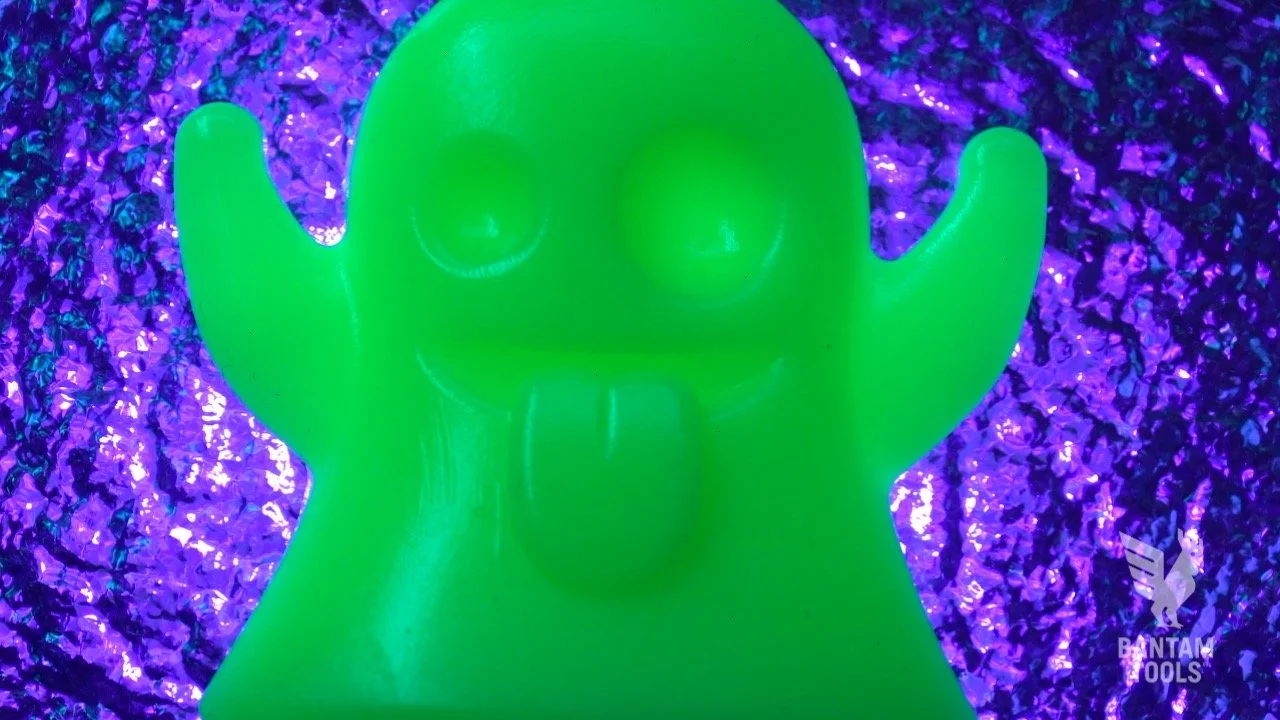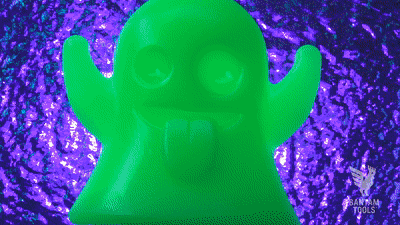CNC Machining Master Molds
Things may be getting a little spooky at Bantam Tools HQ, but we ain’t afraid of no ghosts! For this year’s Halloween project, our video producer Peter Riley decided a mold-making project was well overdue. He’s been wanting to use the Bantam Tools Desktop CNC Milling Machine to mill molds for a while now, and what better way to celebrate Halloween than to make molds for glow-in-the-dark ghosts! Get more insight into the materials and end mills he used, Fusion 360 design tools that came in handy when he created his model, and getting started tips if you want to dive deeper into mold making using your CNC machine.
Why did you choose machining wax for this project?
I don’t use machining wax near enough! It’s a great material for high-speed prototyping because it mills in no time. It’s about as close as you can get to cutting actual butter using the mill (without the mess). Machining wax is specifically designed so it can be cut in a CNC machine without melting, and unlike other waxes, machining wax retains fine details well. I was very surprised by this the first time I milled Jon Snow out of machining wax using the Bantam Tools PCB Milling Machine.
When it comes to making things out of silicone rubber or silicone rubber molds, machining wax is also nice because it won’t stick to the cured rubber. This means you don’t have to worry about using spray lubricants during the mold-making process.
Oh! Did I mention how smooth and quick it cuts?
How did you design your mold in Fusion 360?
Creating the “goopy ghost” (as I call it) in Fusion 360 was a fun exercise—especially for me. I’m not a skilled sculptor. My bonafides include watching Keith get teary eyed on The Great Pottery Throw Down and using the Play-Doh Burger King toy set.
I started by importing an image into Fusion 360 as a canvas and then used Sketch tools to create half a bell shape. I then used the Revolve tool to create a perfectly rounded 3D bell based on the sketch. This strategy is great for creating curvy, symmetrical shapes with nice sweeping lines.
For the arms I created a series of sketches, each with one circle aligned to various Offset Construction planes. I then used the Loft tool and connected each circle to the next. Until this project, I only had a theoretical understanding of the Loft tool. If someone is just starting out, I recommend digging deeper into the support materials provided by AutoDesk to learn about the Loft tool—or any tool for that matter for more step-by-step instructions.
Once I had a perfectly rounded bell with two arms sticking out, I used the Scale tool to smush the ghost down. I then used a couple spheres to create the negative space for the eyes using the Combine tool. The tongue and mouth were done in much the same fashion using custom shaped bodies derived by extruding from sketches. Once I had a positive of the ghost in Fusion 360, I was able to sink it into another body I created (literally just a rectangle) and created an inverse, which would become my mold. If you’re new to Fusion 360, I’d recommend checking out the Fusion 360 Design Academy Training. I also use Fusion 360 blog regularly, as well.
Image from Harvey Tool’s “Ball Nose Milling Strategy Guide”
What end mills did you use to machine your project?
I’m all about big chips for the camera—and of course efficiency. So I used a Datron 6 mm single-flute flat end mill because I knew it would make quick work of the machining wax during roughing operation. I then followed up with a 1/8” ball end mill doing a fine stepover finishing pass.
For the finishing pass on this mold, I used a 0.004” stepover with the 1/8” ball end mill. It was a good balance between speed and quality. When creating rounded surfaces with a ball end mill, you have to account for scallops left behind between each pass. The curvature of the ball end mill doesn’t exactly match the curve of the part surface, so there is always a bit of excess stock left behind.
This concept is best demonstrated at the extreme. Imagine a one inch diameter ball end mill doing passes exactly once inch apart at the same depth across a flat surface. The finished floor won’t be flat, it’ll have grooves. The same general principle applies when trying to use a tennis ball to dust a shelf—good luck reaching the corners! In short: Tool geometry matters!
What tips would you give people looking to machine molds using the Bantam Tools Desktop CNC Milling Machine?
Remember that you’re milling the “negative” and not the “positive.” Your design considerations related to tool geometry and reach apply to the negative, aka the mold. The positive is the finished part that comes out of the mold and while you need to keep the positive in mind when modeling the negative, it’s the mold that you need to design for machining. This is actually quite liberating and a fun break from how I usually machine, which is to focus on the finish part.
If you get ambitious and do a two-sided mold, an injection mold, make sure you focus on how you’ll keep your two molds aligned during the injection process. The same sort of techniques and attention to your machining process you use when setting up parts that require flips will serve you well here.
Most importantly, have fun! Mold making is a powerful technique to have in your tool box and should be a joy to learn.
Make Your Own Mold
If you want to make molds of your own, here is a list of tools and materials Pete used to machine this project:
At Bantam Tools, we empower people to push the limits of advanced manufacturing and build their skills by producing CNC machines with professional reliability and precision at an affordable price.









